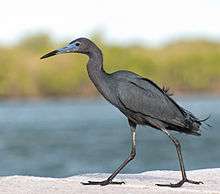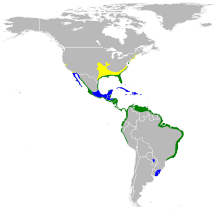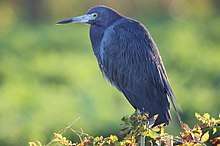Little blue heron
The little blue heron (Egretta caerulea) is a small heron belonging to the family Ardeidae.
| Little blue heron | |
|---|---|
 | |
| Scientific classification | |
| Kingdom: | Animalia |
| Phylum: | Chordata |
| Class: | Aves |
| Order: | Pelecaniformes |
| Family: | Ardeidae |
| Genus: | Egretta |
| Species: | E. caerulea |
| Binomial name | |
| Egretta caerulea | |
 | |
| Distribution of Egretta caerulea: breeding non-breeding year-round | |
| Synonyms | |
|
Ardea caerulea Linnaeus, 1758 | |
Distribution
These herons breed in the Gulf states of the United States, through Central America and the Caribbean south to Peru and Uruguay.[2][3][4] It is a resident breeder in most of its range, but some northern breeders migrate to the southeastern US or beyond in winter. There is post-breeding dispersal to well north of the nesting range, as far as the Canada–US border.
Description
_juvenile.jpg)
This species is about 64–76 cm (25–30 in) long,[4] with a 102 cm (40 in) wingspan,[5] and weighs 325 g (11.5 oz).[6]
It is a medium-large, long-legged heron with a long pointed pale blue or greyish bill with a darker or black tip.[5] The body is more elongated than in Snowy Egret.[2]
Breeding adult birds have blue-grey plumage except for the head and neck, which are purplish and have long blue filamentous plumes. The legs and feet are dark blue/green or greenish.[4] The sexes are similar.[5] Non-breeding adults have dark blue head and neck plumage and paler legs. Young birds are all white in their first year, except for dark wing tips[5] and have dull greenish legs. In their first spring or first summer they gradually acquire the adults' dark plumage.[2][5]
This species is rather similar to the much larger and bigger-billed Reddish Egret. Immature Little Blues are similar to immature Snowy Egrets.[7]
Ecology

These herons prefer freshwater swamps and lagoons in the South, while on islands in the North they inhabit coastal thickets.[4] They breed in sub-tropical and tropical swamps with mangrove vegetation, wetlands (bogs, fens, peatlands, etc.) and marine intertidal salt marshes.[8]
The little blue heron nests in colonies,[4] often with other herons, usually on platforms of sticks in trees or shrubs.[4] Three to seven light blue eggs are laid.[4] The little blue heron stalks its prey methodically in shallow water, often running as it does so. It eats fish, frogs, crustaceans, small rodents and insects. It eats more insects than the larger herons. Adults usually forage alone, while immatures usually feed in groups.[4]
White little blue herons often mingle with snowy egrets. The snowy egret tolerates their presence more than little blue herons in adult plumage. These young birds actually catch more fish when in the presence of the snowy egret and also gain a measure of protection from predators when they mix into flocks of white herons. It is plausible that because of these advantages, they remain white for their first year.[2]
Bibliography
- Steven L. Hilty (2003). Birds of Venezuela. Christopher Helm. ISBN 0-7136-6418-5.
- Herbert W. Kale (1990). Florida's Birds. A Handbook and Reference. Sarasota, Florida: Pineapple Press. ISBN 0-910923-68-X.
- Field Guide to the Birds of North America. National Geographic Society. 2002. ISBN 0-7922-6877-6.
- F. Gary Stiles & Alexander F. Skutch (1990). A guide to the birds of Costa Rica. Cornell University Press. ISBN 0-8014-9600-4.
External links
- Field guide on Flickr
- Florida Bird Sounds - Florida Museum of Natural History
- Little blue heron photo gallery at VIREO (Drexel University)
- Little blue heron species account at Neotropical Birds (Cornell Lab of Ornithology)
References
| Wikimedia Commons has media related to Little blue heron. |
| Wikispecies has information related to Egretta caerulea |
- BirdLife International (2012). "Egretta caerulea". IUCN Red List of Threatened Species. 2012. Retrieved 26 November 2013.CS1 maint: ref=harv (link)
- Little Blue Heron in ebird
- Geographic Range in IUCN
- Little Blue Heron Egretta caerulea - eNature.com
- Little Blue Heron – Cornell Lab of Ornithology
- Robbins, C.S., Bruun, B., Zim, H.S., (1966). Birds of North America. New York: Western Publishing Company, Inc.
- Little blue heron - Egretta caerulea - USGS Patuxent Bird Identification InfoCenter
- Habitat in IUCN
